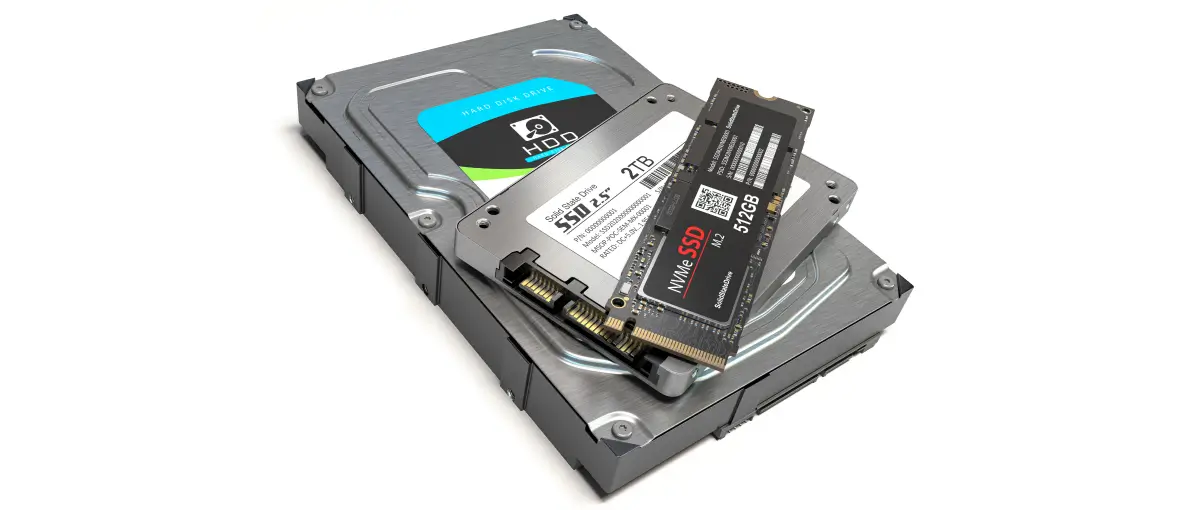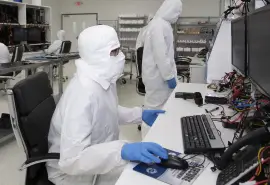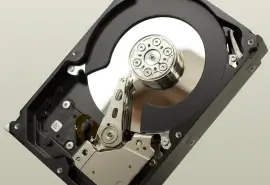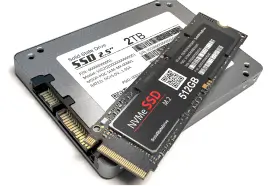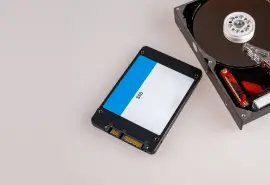Users searching for a storage device in 2024 have thousands of choices. As a result, finding the best hard disk drive (HDD) or solid-state drive can be overwhelming. Yet, the decision has a major impact on performance. Our experts curated a list of leading devices to streamline the process, from high-end drives to low-cost models. Whether building, replacing, or upgrading, we present several picks and tips to help sort through all of the options.
Top Hard Drives and Solid-State Drives (2024)
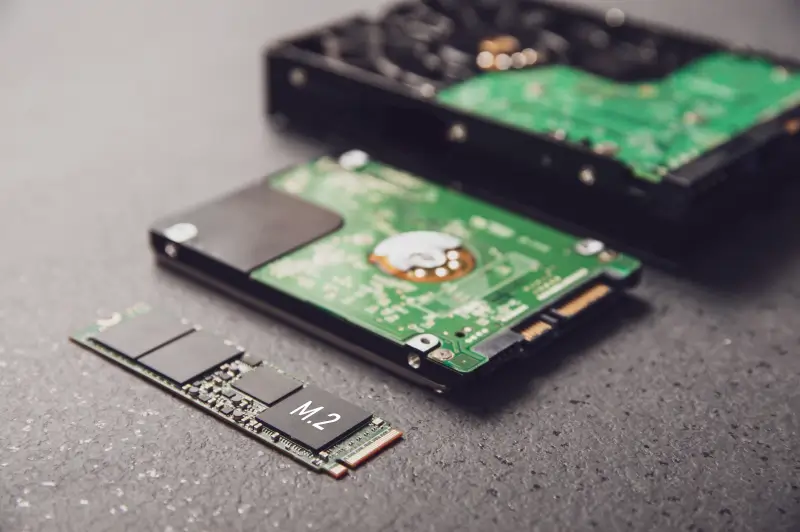
Before continuing, it is essential to realize:
- The ideal drive is the one that fits the budget and suits the situation.
- Warranties are an excellent tiebreaker, given similar performance and price.
We based the selections in this section on our extensive experience and expertise with HDDs and SSDs. While we have partnerships with some companies, they did not compensate us for including their product. These reviews reflect our honest opinion.
This information is tailored toward the average enthusiast and organized into common computing tasks. You might have more specific cost, storage space, or performance requirements. In those cases, it is crucial to determine intended usage and assess numerous models across relevant criteria. For more information on choosing the perfect device, consult our personalized process below.
With that in mind, the following drives warrant careful consideration.
All-Purpose: 2 TB WD_Black SN770 (SSD) | 2 TB Samsung 970 EVO Plus (SSD)
Solid-state drives are the most popular option as a well-rounded device for a home desktop. SSDs have much faster boot times and smoother performance than magnetic storage. Around 2 TB of space is enough for most people to store their operating system, personal data, and favorite applications.
The 2 TB WD_Black SN770 packs a punch at a reasonable price. The compact drive can execute routine tasks, transfer files, and load most games in a flash. Though more expensive, the 2 TB Samsung 970 EVO Plus is another contender for an all-purpose device. The drive offers lightning-quick speeds and enhanced bandwidth, letting users tear through standard processes. Both models have a five-year warranty.
Secondary Storage: 4 TB WD Blue (HDD) | 4 TB Toshiba X300 Pro (HDD)
Some choose to include more than one drive in their machine. A second storage device allows users to distribute data, often improving performance. A small number of people opt for an additional SSD. However, that mainly benefits advanced users with a large collection of files, games, and specialized software. A hard drive will suffice in most cases, providing more room to archive seldom-used data and apps.
The 4 TB WD Blue, backed by a two-year warranty, is perfect. The reliable disk offers ample storage space for documents, movies, music, and more at a much lower cost per gigabyte. In the same vein, the 4 TB Toshiba X300 Pro is great for storing less-accessed files and media libraries. The X300 Pro has a five-year warranty.
External Drive: 2 TB Toshiba Canvio (HDD)
Many people use external drives to create local backups and transport data between places. While external hard drives have cornered the market for decades, portable SSDs have become more attractive as the tech matures. External SSDs are smaller, lighter, quicker, and quieter than external HDDs. They are also more efficient and durable due to their lack of moving parts.
The 2 TB Samsung T7 boasts read and write speeds of over 1,000 MB per second. Those speeds are almost ten times faster than the average external HDD. The T7’s rugged design, impressive performance, and three-year warranty make it a no-brainer for external storage.
The 2 TB Toshiba Canvio is an alternative for those who want a cheaper external hard drive. The Canvio line of portable hard drives have larger capacities, separate specs, and one-year warranties.
Gaming: 2 TB WD_Black SN850X (SSD) | 2 TB Samsung 980 PRO (SSD)
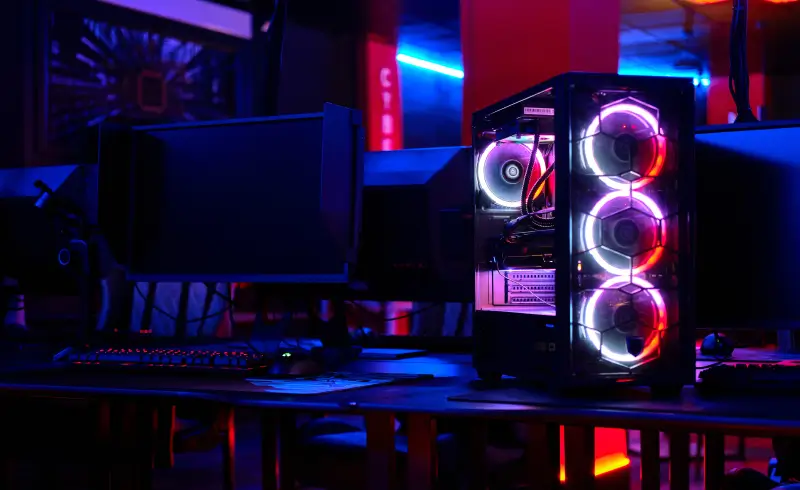
Gaming is one of the most challenging computing tasks given the photorealistic graphics of modern titles. Having a storage device that meets the moment can make a world of difference. Some gamers even put a pair of high-end SSDs in a RAID 0 system for peak performance. However, this configuration is often overkill and requires far more user intervention than a typical setup.
A single 2 TB WD_Black SN850X can still deliver a seamless experience on intensive video games. The SN850X devours data with sequential read speeds of 7,300 MB per second. It also has predictive loading and adaptive thermal management. The 2 TB Samsung 980 PRO is another SSD for next-level gaming. Samsung optimized the model to handle the most immersive, stunning games from prominent publishers. The 980 PRO’s blistering speeds and smart thermal control give gamers short load times and more confidence. Each drive has a five-year warranty.
Note: Storage space remains an intense debate among PC gamers. New SSDs have higher capacities and lower price tags than their precursors. But the size of modern games has also increased in the same timeframe. Now, more AAA titles are exceeding 100 GB. Therefore, a 2 TB drive will allow users to install and maintain more games. Users who rotate through a few titles or download older games might select a 1 TB drive instead.
Professional Design and Editing: 2 TB Crucial T700 (SSD)
Design represents one of the heaviest workloads for storage devices. Editing high-definition video, creating high-resolution images, or developing 3D models requires a drive with breakneck speeds.
The 2 TB Crucial T700 offers breathtaking performance for the pros that depend on it. The T700 features sequential read and write speeds of 12,400 and 11,800 MB per second. Those unbelievable benchmarks make it one of the fastest SSDs around. It loads assets in seconds and renders textures much quicker with cutting-edge software. Crucial estimates the drive can write about 1200 TB of data before exhaustion. These metrics and a five-year warranty make the T700 an easy choice for designers who need top-of-the-line performance.
Note: The T700 is one of the first PCIe 5.0 SSDs. As such, many motherboards will not support the drive. Ensure all hardware is compatible with the interface before placing the device in your computer. Consider using a premium heatsink with the T700 to prevent overheating.
Data Processing: 16 TB WD Ultrastar DC HC550 (HDD)
A data-driven world demands a hard drive that rises to the occasion. While synthesizing large, diverse data sets relies on state-of-the-art processors and an ultra-high-speed network, the storage device still matters. Users need a reliable, spacious drive with a massive cache to manage unstructured data and gather insights from it.
The 16 TB WD Ultrastar DC HC550 is a powerhouse in this environment. For starters, the Ultrastar DC HC550 provides a huge amount of space in a 3.5-inch form factor. The drive’s enhanced read and write speeds do not hurt either. It also has a 512 GB cache to store temporary data and frequently accessed files. This sizable disk buffer improves response times on concurrent read and write requests.
In addition, the helium-sealed drive has cooler temps and less vibration than consumer HDDs, reducing the risk of data loss. The Ultrastar DC HC550 recorded a 0.3% annualized failure rate across 21,607 drives in Backblaze’s 2023 report. That figure was the lowest among all Ultrastar models. Putting multiple Ultrastar DC HC550s in a RAID 1 system is great for complex data processing. The hard drive comes with a five-year warranty.
Enterprise: 16 TB Seagate Exos X16 (HDD)
Enterprise HDDs are defined by their performance in a few categories. They must store large amounts of data in a compact size. They must have a robust design and low failure rates despite constant usage. They must provide better speeds than traditional hard drives.
The 16 TB Seagate Exos X16 is a helium drive that fulfills each requirement for these environments. The 3.5-inch hard drive offers enough space for most small business archives and home servers. It can even be part of a scalable solution.
The Exos X16 is a helium drive with a robust design. In 2023, Seagate’s flagship device had a 0.7% annualized failure rate across 27,433 disks, according to Backblaze. These qualities make the Exos X16 an excellent model for enterprise storage. It has a five-year warranty.
Surveillance: 2 TB Seagate Skyhawk (HDD)
Surveillance cameras often have 24/7 workloads. As a result, they need a hard disk drive that can withstand the stress of real-time recording.
The 2 TB Seagate Skyhawk is a reliable option for DVR or NVR system users. Seagate optimized the Skyhawk to store footage from dozens of cameras and minimize frame drops. It also has built-in sensors to perform in multi-drive bays. The Skyhawk has a three-year warranty.
Security: SecureDrive® (HDD or SSD)
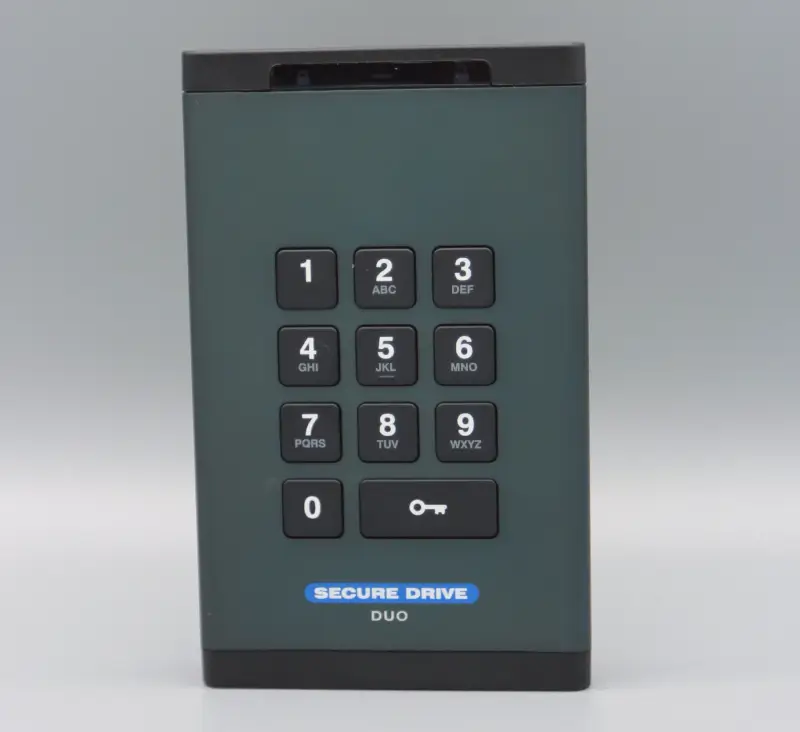
Some users feel unsafe storing critical files on an external hard drive or SSD. That is because the financial fallout of exposing sensitive data can be devastating. But there are encrypted external drives users can trust to transport data.
Our SecureDrive® products, available as HDDs or SSDs from 250 GB to 20 TB, provide hardware-based encryption for secure-minded individuals. SecureDrive® BT allows users to authenticate themselves with a mobile device and perform remote management through a web portal. SecureDrive® KP features a keypad, PIN, and an auto-wipe mechanism to deter brute-force hacking attempts. SecureDrive® DUO combines both approaches in one drive for complete protection. Each model protects personal and private data, even if the external drive is lost or stolen. For that reason, SecureDrive® offers users the ultimate peace of mind.
Hard Disk Drives (HDDs) vs. Solid-State Drives (SSDs)
Experts and enthusiasts continue to debate the merits of HDDs and SSDs. The truth is that these drives use distinct technologies and thrive in different circumstances. Hard disks still store most of the world’s data, but the performance of flash storage is enticing.
Below, we compare typical hard drives and solid-state drives in several areas.
| Criteria | HDD | SSD |
| Media | Magnetic Platters | NAND Flash Chips |
| Capacities | 2 to 20 TB | 1 to 4 TB |
| Price/GB | $0.01 to $0.03 | $0.08 to $0.20 |
| Form Factors | 2.5-inch and 3.5-inch | 22x80mm and 2.5-inch |
| Read/Write Speeds | 100 to 250 MB/s | 1000 to 7500 MB/s |
| Annualized Failure Rates | 0.9% to 1.9% | 0.9% to 1.3% |
| Warranties | 1 to 5 Years | 3 to 5 Years |
| Noise Level | 20 to 40 dB | 0 dB |
| Power Consumption | 5 to 10 W | 2 to 12 W |
The design of HDDs and SSDs often lead to separate roles. Hard drives excel in large-scale infrastructure and situations with continuous recording. That makes them perfect for cloud storage, local backups, and surveillance systems. SSDs are ideal for users that require more performance from their device. In the end, it depends on the person and their needs.
How To Choose the Best Storage Device
Some might want to conduct their own research and handpick the drive that goes in their machine. These simple steps can get you moving in the right direction:
- Determine common tasks and device requirements, including performance and storage space.
- Set a price range to narrow down the list to realistic options.
- Read reviews and compare the product with similar models.
- (Optional) Wait for sales such as Black Friday and Cyber Monday or after the release of an upgrade.
First, buyers must determine common tasks and device requirements, including performance and storage space. Next, users should set a price range to narrow down the list to realistic options. Then, they should compare based on the metrics they have prioritized. If inclined, buyers can wait for sales on computer components. These sales often occur on Black Friday, Cyber Monday, and after the holidays.
Sticking with a reputable brand is advised. These companies have a history of using the best materials, maintaining strict standards, releasing firmware updates, and providing customer support. Lastly, consult the warranties. Warranties can provide a good idea of how manufacturers feel about their product’s expected lifespan. Most warranties do not include data recovery services.
Important Metrics and Specs for Hard Drives and SSDs
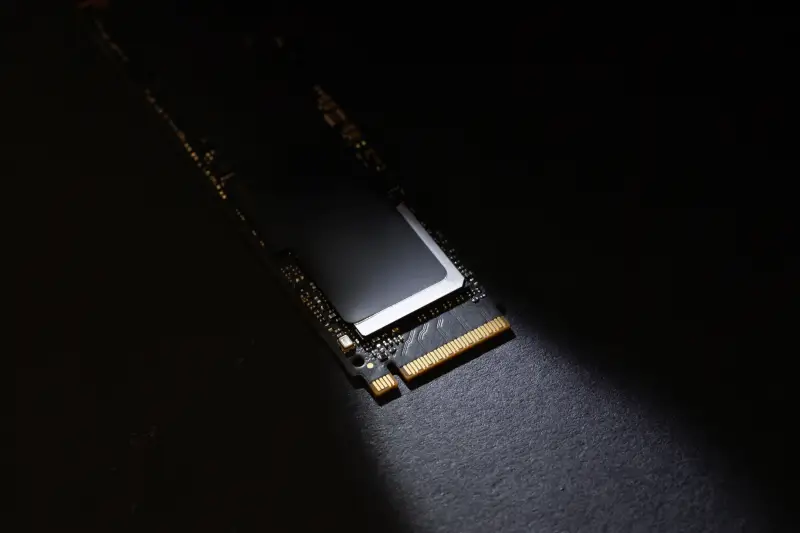
There are several important metrics and specs to know when shopping for a hard drive or SSD. These characteristics can be critical to ensure the device is compatible with other hardware and performing to its potential.
Here are a few details to closely consider before ordering a drive.
Sequential Read/Write Speeds:
- Rate at which a drive can read or write a contiguous block of data
- Tailored toward large files (like games or videos) and backups
Random Read/Write Speeds:
- Rate at which a drive can read or write a non-contiguous block of data
- Suited for managing multiple apps or a bunch of small files
Cache Size:
- Buffer of storage space that provides faster access to frequent data
- Bigger cache leads to faster load times and access rates
Terabytes Written (TBW)
- Measurement of the total amount of data an SSD can write over its lifetime
- Rating helps assess the SSD’s intended usage and write operations
Revolutions Per Minute (RPM)
- Rotational speed of an HDD’s platters
- Higher RPMs represent better performance but produce more noise and wear
NVMe
- High-speed interface that connects modern SSDs to the computer
- Most common interface for newer solid-state drives.
SATA
- Interface that connects storage devices to a motherboard
- Most common interface for internal hard drives
SAS
- High-speed interface for connecting devices to servers and workstations
- Ideal for enterprise environments
PCIe
- High-speed bus and interface for connecting newer SSDs to a motherboard
- Latest generations offer much faster speeds than older interfaces
USB
- Bus and interface that connects peripherals to a computer and provides power
- Most common interface for external hard drives
Effective Strategies To Prevent Data Loss
Remember to maintain the hard drive or SSD after installing it. Like all devices, failure is inevitable. Being prepared can relieve stress and save time when it happens.
Most experts suggest following the 3-2-1 Rule: Storing three copies of data on two devices with one backup kept offsite.
For best results, create a backup schedule and automate the process.
Professional Data Recovery Services
Unfortunately, data loss can still occur despite the best prevention efforts. We can help with catastrophic data loss when backups are not available.
Secure Data Recovery has specialized hardware and software to provide unique solutions. Since 2007, our certified engineers have seen every storage device and failure type. In that time, we have resolved over 100,000 cases and restored billions of files for our customers.

